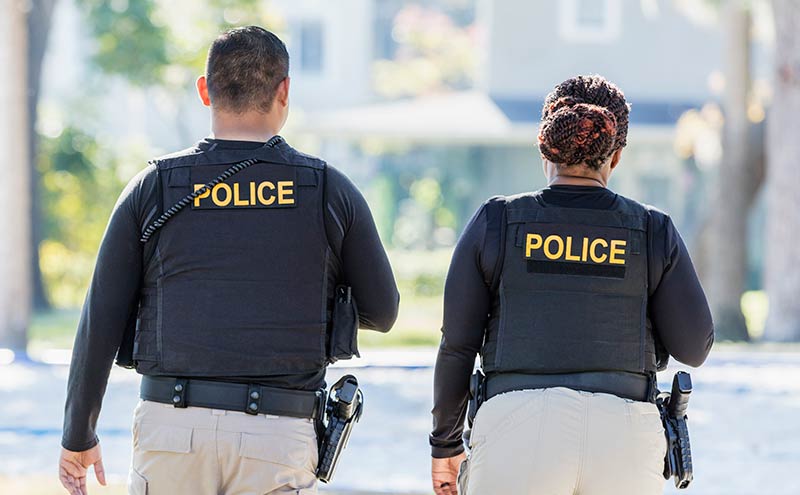
2020 Law Enforcement Officer, Line of Duty Deaths: The Impact of COVID-19
The COVID-19 pandemic has led to a marked increase in US deaths. Data on line of duty deaths (LODD) reveals an even more dramatic increase in mortality of law enforcement officers.
According to the CDC and US Census estimates, the US all-cause mortality rate increased 36 percent from 715 to 970 deaths per 100,000 standard population between the years 2019 and 20201,2,3; however, law enforcement officer (LEO) LODD increased from 149 to 3434, a staggering 130 percent increase in 2020 (Figure 1).
Figure 1
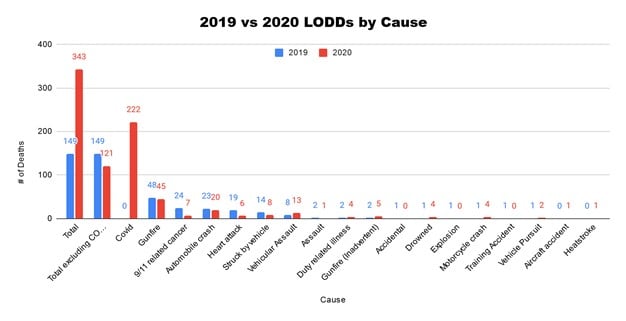
Overall, more LODD were caused by COVID-19 in 2020 than all other causes of LODD combined.
According to ODMP5, total LODD increased 130% from 2019 to 2020; however, when COVID-19 related deaths were excluded, total deaths by all other causes decreased by 19%. Non-COVID causes of LODD which decreased in 2020 include: gunfire, 9/11 related cancer, automobile crash, heart attack, struck by vehicles, assault, accidental, explosion, and training accidents totaling 58 deaths less than the previous year for those causes. In 2020, only 21% of LODD were related to felonious assault whereas in the past ten years prior, felonious assault typically accounted for about 60% of LODD8.
Impact of Officer Age
Based on available Officer Down Memorial Page data, law enforcement officer age is a risk factor for LODD from COVID-19.
While the highest absolute number of cases of COVID-19 LODD occurred among officers 50-59 years old, (figure 3) the incidence of death among officers increased directly related to officer age. Officer age is also directly correlated with higher rates of COVID-19 deaths when compared to all other causes of LODD for that age. (figure 4)
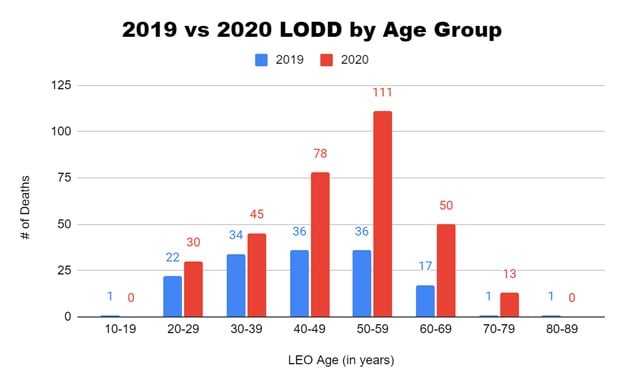
Figure 3
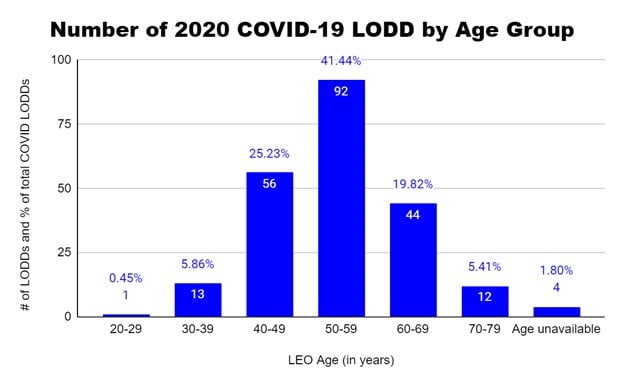
The total line of duty deaths due to COVID-19 per age group and the percent of total COVID-19 LODD per age group. The 50-59 age group accounted for the highest absolute number of COVID-19 deaths and for ~41.5% of all COVID-related line of duty deaths.
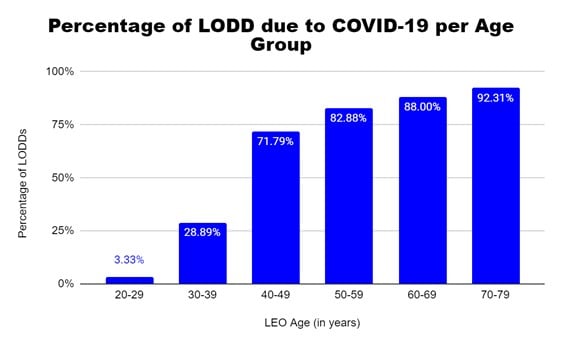
Percentage of COVID-19 deaths as compared to all causes of LODD in each age group.

LODD as a percent of total population of LEO by age group. Mortality due to COVID-19 of law enforcement officers increases with increasing age. Data from Datausa6 and ODMP4
Risk Factors for COVID-19 LODD
What factors make law enforcement vulnerable to COVID-19? An initial review of data as above indicates officer age as a risk factor for COVID-19 death, however more research clearly needs to be done on this topic to discern other factors.
Based on available, albeit incomplete data, no single category of LEO work predominates as cause for increased COVID-19 LODD. The reported LODD exposures occurred via department outbreaks, detention facility inmate and staff outbreaks, assignments to public sites such as COVID-19 testing sites, food pantries, businesses, and also encounters with individuals such as suspects, and members of the public who called for LEO assistance. 5
Along with the type of exposure, one must also consider the possible influence of other factors, such as behaviors particular to LEO, personal protective equipment (PPE) availability7 and compliance, PPE quality and reuse, community case surges, officer race and gender, COVID-19 education and training gaps, increased personal risk factors8, 9 or other as yet, unidentified factors.
Studies in health care similarly indicate a more complicated picture than a simple increased exposure to the public. According to Goudra et. al (2020), general practitioners, family medicine, and primary care physicians had disproportionately higher COVID-19 death rates than other fields of medicine including specialties that had the presumed highest COVID-19 exposure risk10. Goudra also noted that the combined mortality rate of anesthesiologists, emergency medicine, and critical care physicians was much lower than primary care physicians at only 7.4 percent of all physician deaths from COVID-19 compared to almost 4 times the rate among primary care providers. One study suggests limited access to, or reduced compliance or reuse of personal protective equipment may be correlated to higher infection rates in healthcare workers11. Health care workers may also be more aware of the severity of infection outcomes and have a higher suspicion for exposure interacting with a more sick population12. They may thus be more likely to comply with protective measures to prevent disease transmission.
Implications
Clearly more research needs to be done on the topic of law enforcement and COVID-19 vulnerability, prevention and education. Law enforcement databases and definitions are inconsistent. However, based on the introductory information presented in this article, there is a need for expert medical advisors for law enforcement agencies on COVID-19. These medical advisors should consider working with law enforcement agencies on COVID-19 prevention strategies. Medical providers who understand the law enforcement context could help advise law enforcement leadership on agency policies to prevent department spread. Consideration for high-risk groups within the department, such as older officers, might allow for the option of altered work environment or remote work for those officers. Physician advisors must advocate for proper PPE supplies, education and training for their officers and reiterate compliance with its use. Additionally, both individual officers and their agencies may benefit from education and counseling on immunization, lifestyle modifications, and emphasis on preventive health measures.
It is disheartening to discover that the COVID-19 pandemic has so dramatically impacted law enforcement. This data should inspire the expansion of research efforts followed by effective interventions to tackle this tragedy at its core.
References
- Bureau, U. S. C. (2020, December 21). Evaluation Estimates. The United States Census Bureau. https://www.census.gov/programs-surveys/popest/technical-documentation/research/evaluation-estimates.html.
- Centers for Disease Control and Prevention. (2020, December 22). Products - Data Briefs - Number 395 - December 2020. Centers for Disease Control and Prevention. https://www.cdc.gov/nchs/products/databriefs/db395.htm.
- USAFacts. (2021, January 9). Preliminary US death statistics show over 3.1 million total deaths in 2020-at least 12% more deaths than in 2019. https://usafacts.org/articles/preliminary-us-death-statistics-more-deaths-in-2020-than-2019-coronavirus-age-flu/#:~:text=Using%20the%20recent%20estimate%20of,highest%20death%20rate%20since%201949.
- Officer Down Memorial Page. (2021, January 28). Fallen Officers from the COVID-19 Pandemic. https://www.odmp.org/search/incident/covid-19.
- Officer Down Memorial Page. (2021, January 28) https://www.odmp.org/
- Data USA. (2021, January 13). Police Officers. https://datausa.io/profile/soc/police-officers
- First Responder Protective Equipment Challenges During COVID-19. Department of Homeland Security. (2021, February 3). https://www.dhs.gov/science-and-technology/first-responder-protective-equipment-challenges-during-COVID-19.
- Franke WD, Ramey SL, Shelley MC 2nd. Relationship between cardiovascular disease morbidity, risk factors, and stress in a law enforcement cohort. J Occup Environ Med. 2002 Dec;44(12):1182-9. doi: 10.1097/00043764-200212000-00014. PMID: 12500462.
- Hartley TA, Burchfiel CM, Fekedulegn D, Andrew ME, Violanti JM. Health disparities in police officers: comparisons to the U.S. general population. Int J Emerg Ment Health. 2011;13(4):211-220.
- Goudra B, Gouda D, Gouda P, et al. The demography of deaths in healthcare workers – an overview of 1004 reported COVID-19 deaths. 2020 by the American Board of Family Medicine. Ahead-of-print; non-copy-edited version.
- Nguyen L, Drew D, Graham M, et al. Risk of COVID-19 among front-line, health-care workers and the general community: a prospective study. Lancet Public Health 202;5:e475-84.
- Kursumovic, E., Lennane, S., & Cook, T. M. (2020, May 23). Deaths in healthcare workers due to COVID-19‐19: the need for robust data and analysis. Association of Anaesthetists. https://doi.org/10.1111/anae.15116
Daniel Jayasuriya, MS4, M.D. Candidate, JCESOM Class of 2021
Nicholas Newell, MS4, M.D. Candidate, JCESOM Class of 2021
Marshall University, Joan C Edwards School of Medicine



